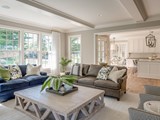Painting Tips for Open-Concept Homes in Southfield

Open-concept homes are loved for their airy feel and seamless flow between living areas. They’re great for entertaining, making spaces feel larger and more connected.
But when it comes to painting, that openness can present a challenge—how do you define different areas without making them feel disconnected?
The right paint strategy can help maintain a cohesive look while subtly distinguishing spaces. Here are some practical tips to achieve the perfect balance.
1. Stick to a Coordinated Color Palette
One of the biggest mistakes homeowners make in open-concept spaces is using colors that don’t work well together. A coordinated color scheme prevents a disjointed look and keeps everything feeling intentional.
- Choose complementary shades that flow naturally from one area to another.
- Neutrals like soft grays, warm beiges, or off-whites create a unified backdrop while allowing for accent colors.
- Use subtle variations of the same hue to add depth without clashing tones.
To make the selection process easier, consider creating a color board with fabric swatches, flooring samples, and paint chips to visualize how everything will work together. This approach ensures a harmonious blend of shades before you even start painting.
2. Use Accent Walls Strategically
Accent walls can create definition without breaking the open feel of your home. A carefully chosen wall can add depth and highlight key areas.
- Select a wall that naturally draws attention, such as behind a dining table or TV.
- Opt for a shade that complements the main color scheme while adding contrast.
- Consider textured finishes or wallpaper for extra dimension without overwhelming the space.
For a unique touch, try a two-tone accent wall or a soft ombre effect that gradually shifts between shades, adding depth while maintaining visual continuity.
3. Define Spaces with Color Blocking
Color blocking is a great way to subtly divide different functional areas within an open floor plan.
- Use different shades within the same color family to separate spaces like a kitchen, dining area, or living room.
- For a bold approach, contrasting colors can define zones while still feeling connected when balanced properly.
- Apply color changes at natural stopping points like archways or furniture placement to make transitions feel seamless.
Another way to achieve this is by using vertical or horizontal blocks of color to guide the eye through the space, making each area feel intentional without losing the openness of the design.
4. Play with Finishes for Depth and Dimension
Paint isn’t just about color—finishes play a big role in how a space looks and feels.
- Matte or eggshell finishes work well for walls, creating a soft and modern look.
- Satin or semi-gloss can highlight trim, doors, and built-ins, adding contrast without needing bold colors.
- Glossy finishes on select architectural elements like ceiling beams or wainscoting add a touch of sophistication.
Using different finishes can also help reflect or absorb light strategically. For example, a higher-gloss finish in areas with lots of natural light can enhance brightness, while a matte finish in cozier corners keeps things warm and inviting.
5. Consider the Impact of Natural and Artificial Lighting
Lighting dramatically affects how colors appear throughout the day. Since open-concept homes have fewer walls, the way light moves through the space is even more important.
- Test paint samples in different lighting conditions—morning, afternoon, and evening—to see how they shift.
- Consider Southfield’s seasonal changes. In winter, colors may look cooler due to gray skies, while summer sunlight can make tones appear warmer.
- Layer lighting with warm and cool bulbs to maintain consistency throughout the space.
Using large sample swatches or painting small test sections on multiple walls can help you determine how your chosen colors will look at different times of the day, ensuring no surprises once the job is done.
6. Incorporate Transitional Elements
If you want some definition between spaces while keeping an open feel, transitional elements can help.
- Use trim, molding, or wainscoting to subtly separate areas without using full walls.
- Paint architectural features like ceiling beams, columns, or built-ins to create a visual break.
- Tie everything together with painted furniture and décor that reinforces your color scheme.
You can also use area rugs, shelving, or room dividers in colors that complement your palette, adding structure while keeping the design cohesive.
How Professional Painters Can Make the Difference
Painting an open-concept home requires a careful approach. Hiring professionals ensures that your color choices and transitions are expertly executed.
- Professional painters can guide you in selecting the right shades, finishes, and techniques for your space.
- They have the expertise to create crisp lines and smooth transitions between different colors and finishes.
- The time and effort saved by hiring experts means your project is completed efficiently with flawless results.
An expert painter can also offer valuable advice on specialty techniques like soft gradients, faux finishes, or custom detailing that elevate your space beyond basic paint application.
Bring Your Open-Concept Vision to Life with Visual Paint
A well-planned paint job can transform your open-concept home into a seamless, inviting space. Whether you need help choosing the perfect color palette or ensuring a professional finish, Visual Paint is here to help. Contact us today for a free quote and let’s bring your vision to life!
